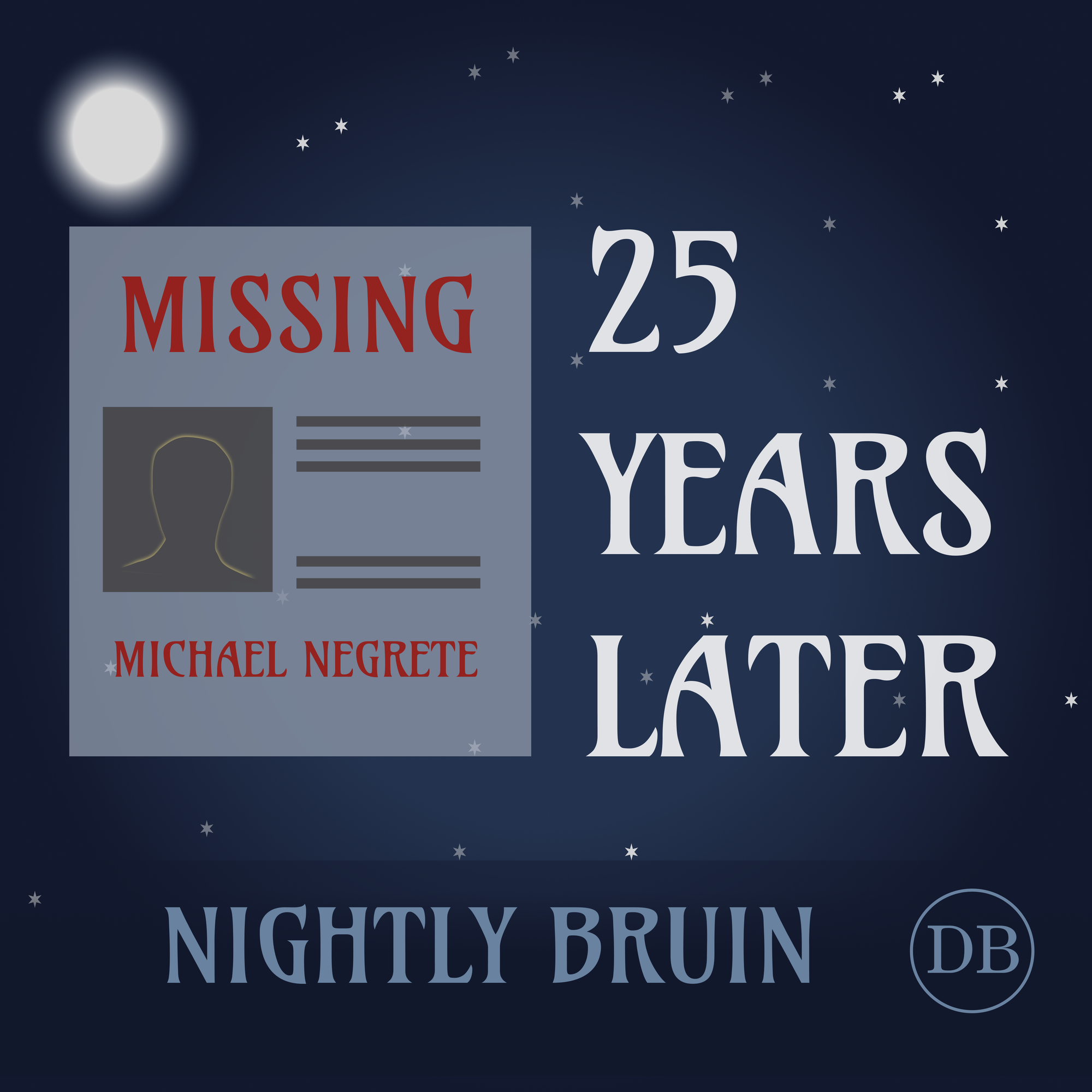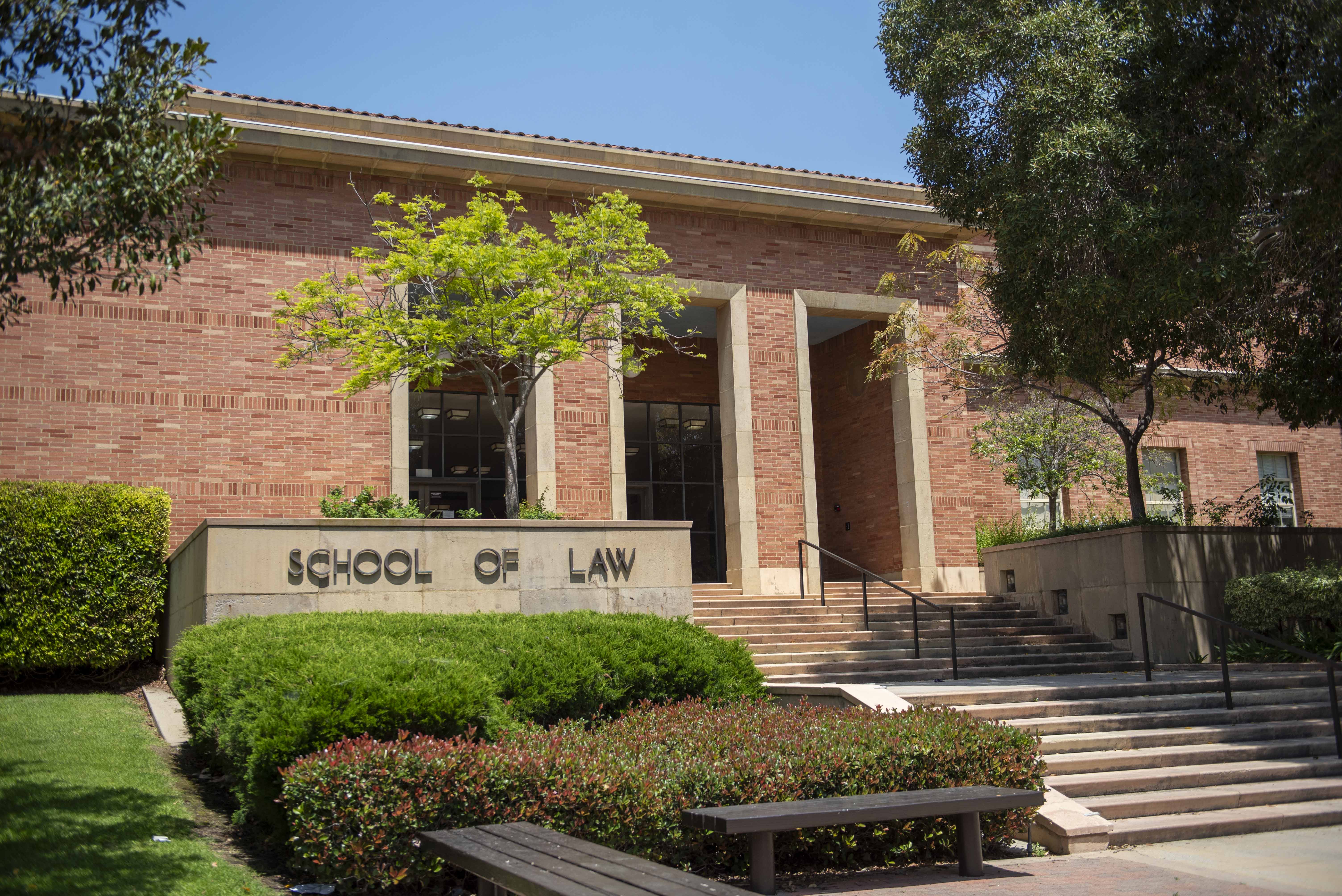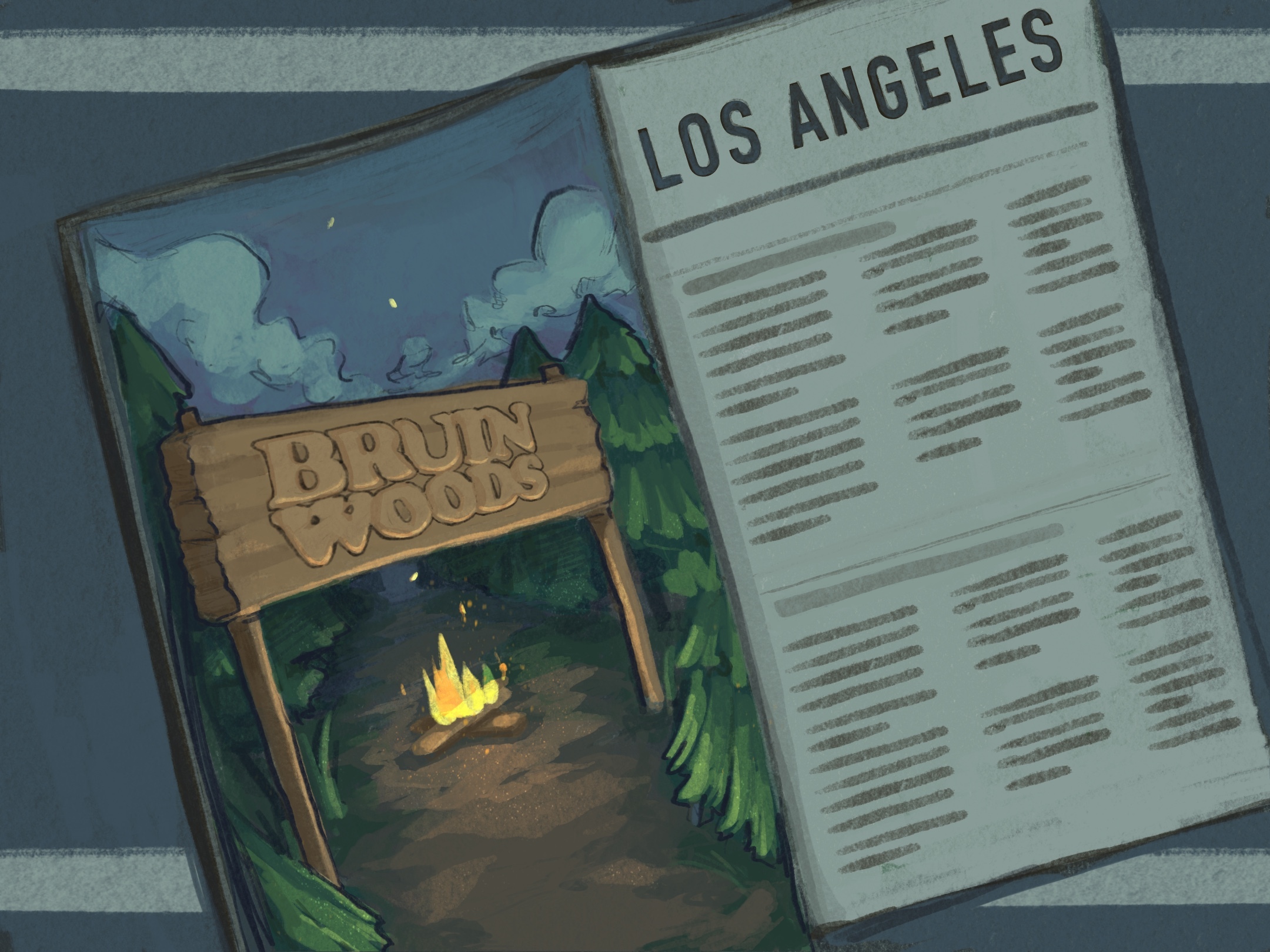Nightly Bruin: The Unsolved Disappearance of Michael Negrete – 25 Years Later

Photo credit: Lindsey Murto
In this episode of Nightly Bruin, hosts Olivia Miller, Mia Fernandez and Jina Bae investigate the disappearance of Michael Negrete from UCLA’s Dykstra Hall in 1999, examining multiple theories about what happened that night, speaking with current UCPD officials about the ongoing investigation and a friend of Negrete’s. Through archival research, interviews with law enforcement and a look at how this case changed campus security, this episode explores both the enduring impact of this 25-year-old cold case and the continuing efforts to find answers about what happened to the 18-year-old music student who vanished without a trace.
Olivia Miller: Dykstra Hall – the first co-ed residence hall in the country, the first dorm on the Hill and the last place Michael Negrete was seen on Dec. 10, 1999, here on the sixth floor.
Listen as we speak to Jeff Chobanian, the acting captain of the UCPD, William Hodgman, the director of special investigations, and even a friend who was there, on Dec. 10, 1999.
Mia Fernandez: My name is Mia Fernandez, and you are listening to the Nightly Bruin.
Let’s start at the beginning. Michael Negrete disappeared without a trace 25 years ago today. He was born on March 25, 1981 and grew up in San Diego with two brothers. He was a talented musician who played trumpet and steel drums in a band called Island Fever.
The 18-year-old freshman was here at UCLA on a music scholarship.
On Dec. 9, 1999, before he had disappeared, he performed with his band in a concert. That final performance would prove to be significant. After the concert, he attended a party with 15 to 20 other students in Dykstra Hall. At around midnight, he returned to his room and began playing an online computer game with a friend who lived in the same building while his roommate was asleep. At 4 a.m., he left his dorm to congratulate his friend on winning their match.
And after that, his friend witnessed him walking back toward his dorm, which was the last confirmed sighting of Michael Negrete.
When his roommate woke up at 9 a.m. on Dec. 10, Michael was gone but all of his belongings remained, including his wallet, keys and shoes.
As minutes turned into hours, and hours turned into days, a search was launched, with police searching garbage chutes and construction sites on campus.
Bloodhounds tracked his scent to a bus stop at Sunset and Bellagio, about a mile from campus where the trail ended.
Police interviewed bus drivers and riders who were on the buses at that time.
Seven months later, a UCLA student came forward with information, reporting seeing a 35-year-old caucasian man hovering around Dykstra Hall at approximately 4:35 a.m. on the night of Michael’s disappearance. The student provided a detailed description so investigators were able to construct a sketch.
The witness had reported the sighting during the initial investigation, but local law enforcement didn’t pursue it at the time.
No activity from Michael has been recorded since his disappearance.
He sent an email to his mother hours before he vanished including plans to come home for winter break.
So what happened to Michael Negrete?
To this day, no one knows. The case escalated from a missing person to a potential homicide investigation.
His family put up $100,000 to hire two private investigators. Several theories have emerged over the years. Please keep in mind that when discussing these theories, none of these have been proven and are only speculation into the possibilities.
One of the theories involves a 2013 Tumblr post from Negrete’s brother. This post indicated that Michael began attending raves and experimenting with drugs, ecstasy in particular, during the weeks leading up to his appearance. His brother wrote that he suspects that getting involved in the rave scene led to Michael’s disappearance.
Another theory suggests he left the building and went to Bellagio Street and Sunset Boulevard to meet with someone that could’ve been linked to the disappearance. However, there is limited evidence because his computer’s shared drive was erased while in campus police custody.
There’s also another theory that has circulated. There were many construction sites around the campus at the time of Michael’s disappearance, and he may have accidentally fallen in a site pit, and this may have been covered up by a construction company. However, police thoroughly searched construction sites and didn’t find any evidence of this.
Another possibility indicates Michael Negrete died inside Dykstra Hall on the sixth floor, as a result of an overdose or violent altercation, and his body was removed by students who fabricated a story to mislead investigators.
An alternate explanation suggests he deliberately vanished from UCLA due to finals or academic pressure.
As I mentioned, this is all speculation and no theories have been proven. What we do know is that Michael Negrete is still missing, and we share this information today as it has been 25 years since he first disappeared.
Now, Olivia Miller will speak with experts on this matter.
OM: Just to start off, would you all like to introduce yourselves?
William Hodgman: William Hodgman.
Jeff Chobanian: Jeff Chobanian.
OM: What’s your affiliation with this case and with UCLA in general?
JC: My affiliation with UCLA is I’m temporarily the operations captain—they call it an acting captain. Normally a lieutenant, I oversee the investigations division.
WH: And my title is Director of Specialized Investigations. Since May, I’ve been working with the UCPD in an advisory assistance capacity with regard to the unrest that occurred last spring and helping UCPD any way I can.
OM: And what is your affiliation with this case? What do you know about Michael Negrete?
JC: It’s what we consider a cold case, meaning that all the leads that the police got at the time were exhausted, and now there are nothing further actionable to follow up on. My role is to oversee the detective division. We periodically look at cold cases to see if there’s anything we can follow up on – any new information, new technology, things that might assist us in solving the case. I became aware of the case earlier this week.
WH: I was asked to review some murder books from the UCPD as well as the Sheriff’s Homicide unit. My experience base was that I was with the LA County District Attorney’s office for 39 years. I’ve tried many murder cases, and from that perspective, I was asked to take a look at the books and see what we had.
OM: Could you walk us through where we are right now? It’s a quarter of a century later – what’s going on now? Where does the investigation stand? What kinds of efforts are being made to look into it?
JC: It’s a good question, and it’s complicated. Once all leads are followed up on, it goes into something called due diligence, where periodically a detective will look at and review the case. Based on the notes we saw when we reviewed the case last year, the investigative lieutenant took a look at this case, reviewed the book, and tried to assess if there was any new information they could follow up on. At the time, the lieutenant determined there was nothing new and put the book away.
We got it back out this week, actually, in preparation for this podcast, and started looking at it again. We started talking about what we could do now potentially. One of my backgrounds is in technology investigations—is there new technology available that we could use? Because of the type of evidence we have in this matter, it isn’t really impacted by the developments in technology with cell phones, computer forensics, or mobile forensics. We don’t think from that perspective that there’s any new follow-up we could do. Now, that doesn’t mean the case is closed, but that is one of the delays in us trying to crack the case.
WH: The Sheriff’s homicide bureau was active in the case back in 2000 through the end of 2001. The case remains open with sheriff’s homicide, but since late 2000, there have been no new clues, no new contacts.
OM: Could you walk us through what we know about some physical aspects of the case, like the areas involved in the search efforts that occurred?
JC: From a universal perspective, we’re not looking in any specific place because we have looked everywhere. To give you some background in reviewing the documents—and both Bill and I were not directly involved in this case, but we have a lot of experience in different capacities—it was a very thorough investigation. When we went on the Internet to see what people thought of the case, we saw some critiques of what law enforcement did. But what the police officers, fire department, community service officers, and ORL did at the time—they searched every piece of this campus, Dykstra Hall specifically. No stone was left unturned. They talked to every single person in this building.
WH: About 900 people lived in here at the time.
JC: Yes, they sent out 900 questionnaires. They sent a person down the trash chute—someone actually rappelled down to look for any clues. They searched every spot in this building specifically, and then all around campus as well. So to answer your question directly, we’re not necessarily looking anywhere specific for the remains.
OM: This did occur during finals week in 1999. How do you think this timing could have affected what happened?
WH: Personally, I don’t think the timing would have impacted the investigation at all. As Jeff said, the investigation was exhaustive. I was very impressed with the detail and comprehensiveness of the investigation. Each dormitory on campus was surveyed at the time. Efforts were made to contact every student in Dykstra Hall. The investigation was very detailed, very exhaustive, and I would have to say I was impressed by the quality of it.
OM: You mentioned technology and how it improves when we look at these cold cases with a new perspective. What’s an example of some investigative technique or technology that’s developed within the past 25 years that could potentially provide a new outlook?
JC: For this case specifically, I think with the DNA portion, if we did have DNA recovered, you need less amounts of it now to run than you did 25 years ago. We don’t have cell phone tower data dumps, which you have now. If we had some of those records, we could maybe do a better job tracking exactly where they were.
The Internet at the time – I actually was trying to find out what it was. There was dial-up internet. Here at the Hill, we believe it was DSL. There was DSL and cable Internet, these two types of Internet, and they believe it was DSL. He had an American Online, known as AOL account. There were some search warrants that were served to AOL to try to get information.
There’s also something called IRC ICQ, a way of chatting. We have some chat logs that we could potentially – I don’t really even know what information we could get from those chat logs, but we’d have to look and see if maybe from an AI perspective there’s a way we could look at mass amounts of data. It’s just really hard to say. Like we said earlier, based on our independent review, we don’t really see how technology from a strictly high-tech, mobile forensics perspective would be able to better this case.
WH: As Jeff said, the forensic application of DNA, of course, has progressed by leaps and bounds since 1999. But this is a no-body case. We don’t have trace evidence remains which might serve to facilitate a DNA comparison at this time.
OM: Given that Michael had just turned 18 some months earlier, how would this case be treated differently if he was younger? If he was 17, would there be a different level of urgency or outlook on it?
JC: There are different legal requirements, but none of those would come into play here because we aren’t going to wait 60 days to investigate. There are certain things we’re required to do by law if it’s a juvenile who’s under 18. But no, this case was quickly investigated. There was a little bit of delay in reporting, which no one is to blame for. I think some of the roommates just weren’t sure what he was doing. It’s 1999, so not everyone had a cell phone in 1999. It wasn’t weird for someone to just be gone for a weekend with no contact. And then when he missed a performance on Sunday, that kind of sped this along. That’s when his mother first called the police department. So I don’t think his age had anything to do with the response time.
WH: I concur. I didn’t see any evidence of any delay based upon age. If anything, once UCPD was alerted, they swung into action and the investigation right out of the box was very comprehensive.
OM: How does this case fit into the broader picture of campus safety – campus safety historically on a large scale or even locally, just at UCLA or in LA?
JC: At a major college campus in the middle of a major metropolitan city, you’re going to have some unfortunate things occur. We still to this day do not know what happened. I can say that the university did make a lot of changes based on this case. The key cards to Dykstra in 1999 were to get access, were on a BruinCard, but they were actual physical keys to get into the rooms. I believe that’s changed. There’s now key cards, security cameras on the Hill. There are a lot of security cameras on the Hill because of this incident. It spawned them to create housing – housing has a massive security camera presence. These are just some examples that are tangible that everyone listening will understand because they can see as part of a bigger part of safety. I don’t think necessarily it’s indicative of what’s normal here. We don’t have students disappearing on a regular basis, thank God. It’s a very safe campus, and we pride ourselves to keep it that way.
OM: You talked about LA being a metropolitan area. Do you think the location of being in Westwood, in UCLA – do you think that has anything to do with what could have happened? Or if you would have taken it out of UCLA and put it somewhere more rural, do you think this has any sort of effect or influence on what could have possibly happened?
JC: Generally speaking, when you’re in a population-dense area, more is likely to occur. It’s just simple mathematics. Sample size – the larger the sample size, the larger that something could happen that’s further away from what’s normal. However, you also have to take the positives of being in a major metropolitan city. You have numerous police departments like Bill alluded to. You have numerous resources. So if you’re in a rural area, you might not be able to get a bloodhound, it might take days, whereas we had them here right away. So you take the good and the bad. With being in a major metropolitan city, obviously more happens here because there’s more people and the population is more dense.
OM: Given the new technology advances, is this something that’s likely to occur again? Or is it something that we have a better grasp on just with things advancing in technology, developing and security cameras?
JC: Nothing is foolproof. I wish that there was a way that we could ensure that this never happened again. I can’t with a straight face tell you that something like this would never happen again. But with safeguards in place, with technology in place, with cell phones, with cameras, with DNA evidence, we are seeing case clearance rates go up. Now, one of the other issues is that law enforcement as a whole have less people. There’s some recruitment issues, so you have less detectives. And so that can also cause problems with follow up and ensuring that we do everything that we possibly can do for each case.
WH: The only thing I would add is as recent as today’s news where a health insurance executive was murdered on the streets of Manhattan – already within 24 hours, they had security video being able to place them at a coffee shop at various points in time. Potential DNA is there. The investigative possibilities are much greater today than they were in 1999.
OM: How can the community best help with cases like this one?
JC: The first thing, if anyone has any information, is to call our dispatch center, 310-825-1491. Secondarily, the community can always do their best to engage in behavior that makes you less of a victim. What that means is try to always be with a friend, don’t walk alone, tell somebody where you’re going to be. Ensure you’re taking care of yourself, ensure you’re taking care of somebody else, too. Some people argue that in 2024, we’ve lost our sense of community. I disagree with that. I think that our community is stronger than ever. I think our partnerships are stronger than ever. I think our relationships with students are great. So really, I think as long as everyone works together to achieve the common goal of their own safety, then other people’s safety just organically gets boosted up.
WH: I would add that a theme often cited today is, “If you see something, say something.” At the time, in 1999, flyers regarding Michael were distributed across campus and in the Westwood community and the business community, all in an effort to, if someone saw something, please say something. Take the initiative to step forward and help if you can. I think that sense of community, as Jeff describes it, is even stronger today than it might have been back then. Community responsiveness would be helpful.
OM: Is there anything else that you all would like to add about the case or that we didn’t cover?
JC: I would just say my thoughts and prayers go out to the family. This is a tragedy. And this not only was a tragedy for the family, but it was very tragic for this university. When Bill and I were talking with people around the station that we’re going to do this – keep in mind, this happened 25 years ago – the people who had been there knew exactly what this case was, and you could tell that they cared about this case. Twenty-five years might seem like a long time, but if you’re the family member of a lost loved one, it’s not that long.
WH: And as Jeff suggested, perhaps this very podcast, and to the extent that it’s broadcast on YouTube or whatever, if it inspires someone to make a recollection, perhaps they didn’t step forward years ago. Any new information would be appreciated and contact the UCLA Police Department. A case can still be worked, even if it’s 25 years old.
OM: Thank you so much for coming on the podcast.
JC: Thank you for having us.
WH: Thank you.
MF: Thank you, Olivia. Now, we will talk to contributor Jina Bae who is with Ross Wolf, a UCLA Alumnus who hosted the party Michael attended before he disappeared.
Jina Bae: Hello. I’m Jina Bae from Daily Bruin Podcasts, and I’m a contributor here. Today I’m joined with Ross Wolf. So how do you know Michael Negrete, and what role did he play in your college life?
Ross Wolf: I knew Michael the first couple months of college. He lived across the hall from me my freshman year, and we quickly became friends. He was one of my best friends before he disappeared.
JB: How did you hear about Michael Negrete’s disappearance?
RW: We actually were the ones who reported it to the police. We’d hosted a party in my dorm room, and Michael had been at that party – I think it was probably Friday night. A bunch of people were there, and then he’d gone back to his room after that, which was right across the hall. The next morning he wasn’t in his dorm room, and we all just assumed that he’d gone off to band practice or something. As the weekend went on, we realized – I think probably Sunday – “Hey, no one’s seen Michael. Where is he?” He’d missed some of his band practice, and someone had called. We realized that no one had heard from him, so we ended up calling the police.
JB: What was life like in Dykstra Hall after his disappearance?
RW: I think it depended a lot on the individual. At first, when this happens, you figure there’s probably a reasonable explanation, and he’s probably going to turn up somewhere. It didn’t really sink in with a lot of people how serious and mysterious this was. In addition, there were investigations that occurred. Not everybody knew Michael as closely because in the hall, there’s lots of different dorm rooms. People knew each other reasonably well, but if the rooms weren’t adjacent, you weren’t necessarily good friends. People who were close to him went out to distribute flyers and stuff like that. Those who knew him well were affected pretty hard – they were worried, sad, down a lot. Over time, obviously different people recovered at different rates, so it wasn’t a continuous feeling across the hall.
JB: You mentioned about flyers, and I wanted to ask you a follow up question. What actions did you or any close family members or friends of Michael Negrete take in the first months in attempts to find Michael?
RW: We had flyers and we were going to various neighborhoods that we thought maybe he would have a proclivity towards, asking if anyone had seen him, showing his picture, putting up missing person flyers. This was everything from places in San Diego that he’d been to, places in Hollywood that we thought he might have gone to – the police at one point thought he’d gotten on a bus. We went to main thoroughfares where people might have seen him, places in Long Beach near where he’d lived. Any communities that we thought we could raise awareness in. We were working with the police, private investigators and the FBI as much as possible to assist them in trying to figure out what happened.
JB: What do you think caused this case to lose visibility?
RW: I don’t know that it fizzled out. I know the investigations continued, and his family had private investigators looking into it. For a lot of people, Michael wasn’t someone they were close to. School starts in September, and he disappeared in December – most people only knew him for a couple months. People have to heal, and they can’t worry infinitely about something where there really are no answers. To some extent, it’s probably a self-defense mechanism where they didn’t want to be confronted with it all the time. People heal at their own rates, depending on their closeness to Michael.
JB: Are there any actions currently taking place?
RW: I’m not aware if there are. His family had some private investigators trying to figure out what happened. I met with them after I’d moved to Washington State and talked to them on the phone a couple times, but this was more than 10 years ago. Besides yourselves, I haven’t been contacted by anybody, so there may be things going on, but I don’t have any awareness of what those might be.
JB: Is there anything else you would like to add that we weren’t able to cover today?
RW: I’m still sad to this day about it. Part of me likes to hope that somehow – it’s still a mystery, right? It could have been foul play or something horrible, or it could have been that he decided to disappear. I like to hope that somehow he’s at peace.
JB: Thank you so much for joining us, Ross.
RW: Thank you.
MF: Before we end, we would like to share a few words from Michael’s brother, David Negrete.
“Michael was my biggest hero.
When I became a young teenager I absolutely looked up to him, and I was so inspired by his talents. And he was talented.
Everything was so easy for him. Math, physics, and especially music.
One of my favorite memories is when he came home one day from high school and showed me a CD of John Coltrane’s Giant Steps. I had just started playing saxophone, so he was excited to sit me down and have us listen to it together. He did that quite often with other artists that he wanted to share with me.
He always gave me the motivation to play music, and be better at it. But he did it by example. Mike was gifted on the trumpet. He had such a bright future with it. Everyone around him was always in awe of the sound he made on it. He won awards and was constantly placed in honor bands and orchestras, both in classical music and jazz. And it came easily for him.
Everyone truly loves Mike. We all miss him deeply.
To this day I strive to make him proud.
Still, and always, my hero.”
Thank you for all listening, I am Mia Fernandez and this has been the Nightly Bruin.




